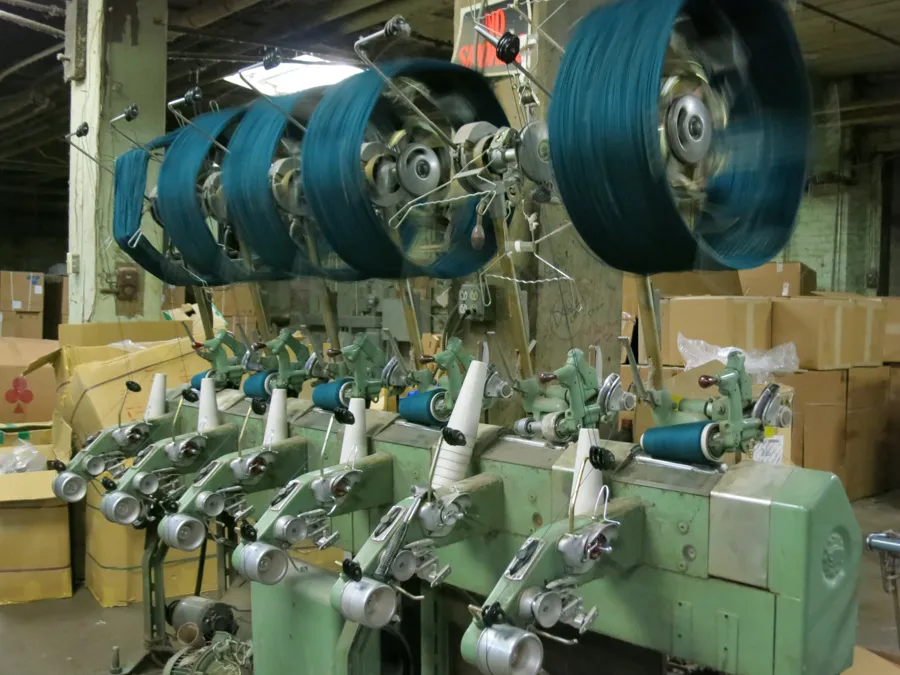Walter Licht Speaks on Philadelphia’s Textile Heritage

In the summer of 2012, Mural Arts Philadelphia has placed six regional artists in residence at six Philadelphia textile manufacturers. These residencies are part of Structure and Surface, an exploratory project that works to uncover the legacy of Philadelphia’s declining textile industry. One of the project’s advisory committee members, Walter Licht—Walter H. Annenberg Professor of History at the University of Pennsylvania—offered this intricate picture of the city where we set our scene: a city of niches and networks. A city of limitations and adaptation.
“There’s no one person this is about,” Licht told the group of manufacturers, artists, and advisors involved in the project. “There’s no one industry here, no one invention.” When the industrial revolution of the 19th century hit Philadelphia, it was “just a spectacular mushrooming of activity.”
After its prowess as a bustling commercial port of the colonial era was lost to New York City in the early 1800s, Philadelphia re-invented itself as an industrial hub. It produced a range of goods and services— cotton to chemicals, paints to printing—in a diverse, highly-specialized network of small to medium businesses.
As Licht reinforced throughout his talk, each of those terms you just read is essential to Philadelphia’s story.
Diverse—unlike the anthracite towns further north along the Delaware River, which attracted general laborers to work in one industry, Philadelphia saw a settling of highly skilled craftspeople under a broad umbrella of specialized industries, working in settings from home workshops to larger, water-powered mills.
Highly specialized—because Philadelphia manufacturers served very specific niches, they were able to proliferate and succeed, not at the massive level of large-scale coal mines or New England textile mills, but at a more modest, medium-sized level that served specialized, custom needs—Disston saws, Baldwin locomotive engines, S.S. dental instruments.
Small to medium businesses—because Philadelphia manufacturers operated at a smaller scale, they proved to be more nimble, and able to quickly change when social, economic, or technological situations called for them to adapt, reinforcing a strong network of industry.
Network—Philadelphia’s manufacturers weren’t the type to produce their products start to finish, all under a single roof. Rather, they were a link in a larger chain, each working on some detail of a product before passing it down the line, creating a situation where collaboration with their neighbor-businesses was not only common, it was necessary.
“There was production going on in every crevice, nook and cranny of this city,” Licht said. “You could go from place to place to get a finished product. It can go through different kinds of venues, starting in a mill, ending up in a home.”
Limitations, Proliferation, and Decline
Part of the reason Philadelphia became such a specialized town is because it didn’t have the work force to grow big. There were no major waterfalls, and thus no source of waterpower to run a large scale mill (short of the man-made canal system in Manayunk, and locations along the Wissahickon Creek where operations like Glen Echo Mills settled). The city didn’t compete, because it couldn’t compete, and instead found success in specialized operations run mostly by German and English immigrants. (In 1880, 75 percent of the city’s textile firms were owned by first-generation immigrants.)
The major industrial zone in Philadelphia was the Delaware River corridor—the area that is today Northern Liberties, Fishtown, Kensington, and Port Richmond. In 1910, Kensington alone housed 400 textile firms, employing 30,000 workers. Other regions of the city became hubs as well, such as lower Germantown/Nicetown.
At its peak in the 1950s, 44 percent of all Philadelphians worked in manufacturing. There were 375,000 jobs in the Northern Liberties and Germantown corridors alone. Today, that has declined to just about 22,000 manufacturing jobs, or 3 percent.
Textiles in Philadelphia
Of Philadelphia’s varied industries, textiles stretch back the farthest. The region’s first linen weavers were Germans who settled northwest of the city—hence, Germantown—in 1690. If we consider that the start of the city’s textile industry, Licht said, we’ve clocked some 322 years of steady textile production.
“Aside from India or China, I don’t think I can find any place in the world that boasts three centuries of linen manufacturing,” Licht said. “I think we should celebrate the utter longevity of it.”
Notable firms include Dobson Mills in East Falls, which was famous for securing the largest order of woolen blankets for union soldiers during the Civil War, and John B. Stetson Company. The latter is famous for its 10-gallon cowboy hats, but successful for its more common wares—in 1925, one in four American males wore a Stetson bowler.
Because Philadelphia manufacturers were smaller-scale, they were more nimble and easily able to shift production in ways that larger textile mills could not. Licht gave an example of Wm. Sholes and Company, a rug manufacturer based at Wayne Junction—the current home of Structure and Surface-participating manufacturer Wayne Mills. During the wool shortage around the First World War, Sholes was able to switch to making rugs from paper fiber, and kept business moving.
Preserving Craft, Preserving Knowledge
The network of manufacturers, Licht explained, is what kept the industry alive.
“The density of workers and the remarkable exchange of expertise is why it survived and did so well,” he said. Philadelphia was “a swirl of information”—door-to-door exchanges, shop-to-shop, and ultimately the creation of institutions for the sharing of knowledge and expertise.
In an apt twist, Licht noted, before the Philadelphia College of Textiles and Sciences founded its East Falls campus in 1887, the Philadelphia Textile School was housed inside the Philadelphia Museum of Art.
“They didn’t see a distinction between art and production,” Licht said. “It’s all the same, it’s about design, it’s about skill and craft. There was a deliberate attempt to preserve that knowledge, and I think that’s what we’re doing around this room.”